
The Qohenje Script (Qoḥenje Kêĵen) is the written form the Qohenje language (Qoḥenje Ṁjâ'ak), the native language of Genus Qihira-Tejlija in the Rhadyuas Cycle novels by Harrison C. James. You can contact the author at info@hcjpublishing.com, or via his website and you can get detailed notes on all aspects of the Qohenje language by becoming a Patron.
Qohenje is a very unusual language with a complex and alien grammar that makes it very difficult for non-Qihira-Tejlijans to learn. Its writing system is no less alien, and these are things that the xenophobic Qihira-Tejlija are very proud of. Qoḥenje Ṁjâ'ak (the Qohenje language) and Qoḥenje Kêĵen (Qohenje writing) are central aspects of the Qihira-Tejlijan identity and culture. Qoḥenje is pronounced [kxo.hɛːn.jɛ].
Qohenje script is written left to right, top to bottom. It is a hybrid segmental-syntagmographic system. All content words (lexemes) are written with the segmental elements of the script, which are a kind of "reverse abjad": the main symbols are vowels, while the consonants are marked using a system of diacritics.
Unlike the vowels, which are full segments, the consonant marks are featural, with one set showing place of articulation and another showing manner.
The way these consonant marks are written around the vocalic symbol defines 8 different glyph types, with different syllabic structures.
In addition to the segmental writing, there are a large number of syntagmographs. These are special symbols that play purely syntactic roles (like tense markers, case marks etc). The syntagmographs have fixed pronunciations and are not analysable.
Although there is some variation, Qohenje’s two tonemes are quite consistently marked with
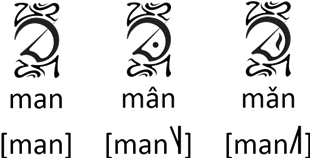
Qohenje recognises 30 vowels. All 30 can carry tone, as shown above.

Most of the place marks have four different forms:
The labialised and palatalised series can occur in isolation (with the palatalized and labialized readings of the isolated set) or in combination with a manner mark. The term "floating" in the table below refers to the isolated manner marks, which are called the "floating" series.
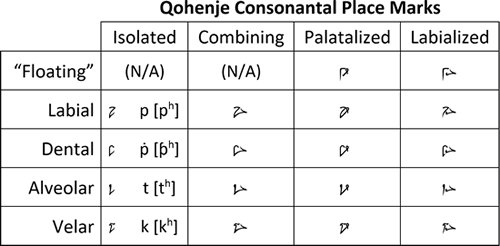
(This table shows the place marks in their upper L -> R orientation only.)
The manner marks only have a single form each, although this does vary slightly according to their position and orientation in the glyph.
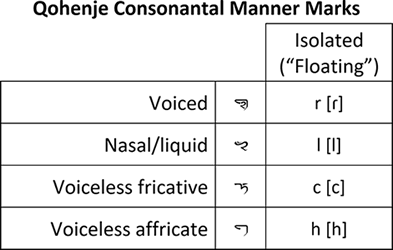
(This table shows the manner marks in their upper L -> R orientation only.)
The Qohenje glyph is an arrangement of consonant marks around a single vowel symbol. The vowel occupies the centre of the arrangement and the consonant marks occur in any of the four corners of an enclosing vertical rectangle which normally has golden rectangle proportions.
The absence of any consonant marks above a vowel indicates an initial glottal stop:
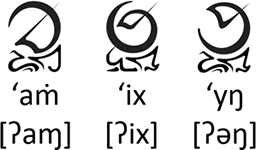
The absence of any marks below a vowel indicates an open syllable (vowel final):
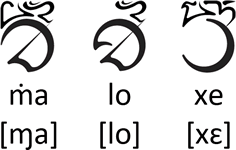
Consonant marks are always oriented with respect to the centre of the vowel symbol, appearing 'upside down' in final positions. They are written either L -> R or R -> L with the symbols themselves flipping orientation along their vertical axis to show which direction they are to be read in.
These orientation variations, in combination with a distinction between unbroken and broken vowels, give rise to 8 different glyph types, many of which have di- or trisyllabic readings, despite only containing a single vowel symbol. Two of these glyph types are also ambiguous between 2 different readings (see below). Only context will determine which reading is appropriate.
In the following table, each type is shown with a diagram which gives its direction of reading, as well as an example (which is also the Qohenje name for the glyph type).
In the diagrams, P stands for place mark, M for manner mark, V for unbroken vowel, and V'X for broken vowel.
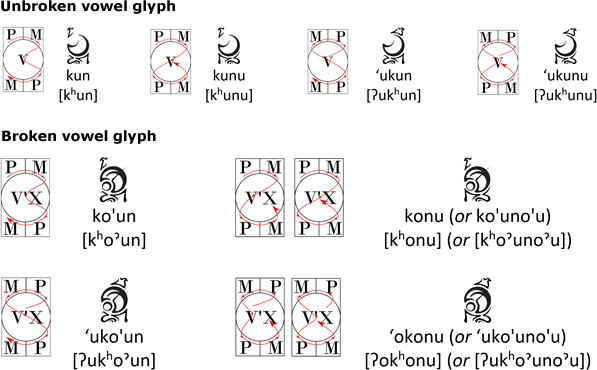
Qohenje script also has 51 purely syntactic elements that are written with specialised symbols - syntagmographs. Many of these have a tail not unlike a ceihan (see punctuation, below), and also serve as lexical breaks. A handful of prefixing syntagmographs are smaller, and float at the top edge of the line. Some examples are given below:

Full lexemes, written in segmental script, are separated off from one another by a vertical slash called a ceihan, as seen at the end of the words ṁehjedi and bê'isnice, below. Syntagmographs, like the verbal auxiliary kwe in the example, themselves act as word breaks and do not take ceihan. The end of a sentence is shown using a doubled ceihan

ṁehjedi ku kwe bê'isnice cusjelagar
[ɱɛhjɛ.ndɪ kʊ kwɛ mbɛ́ˀɪ̀t˥ ˨.nɪ.cɛ cʊ.çɛ.la.ŋgaɾ]
Shelangar is a city near Mvehjendi.

Dâ'ucĵin koŋu mwǔ'anin ‘oḥ mjemwǐlin ‘oḥ ‘ǎĵenin te qalě'a hei rinumu'ukâŋano bennjǎ'aŋ ‘oḥ da ‘oḥ ‘u'angy'uĵa njǐ'iĵ
[ndaˀʊ˥ ˨.tjɪŋ khɔ.ŋʊ mwʊˀa ˩ ˦.nɪn ɔw mjɛm.wɪ˩˦.lɪn ɔh a˩˦.jɛn.ɪn tɛ kxa.lɛˀa˩ ˦ hɛɪ ɾɪ.nʊ.mʊˀʊ.ka˥˨.ŋa.nɔ mbɛn.njaˀaŋ˩ ˦ ɔj nda ɔh ʊˀaŋ.gəˀʊ.ja njɪˀɪj˩ ˦]
All human beings are born free and equal in dignity and rights.
(First sentence of Article 1 of the Universal Declaration of Human Rights)
You can find the book Chiasma: 1 (The Rhadyuas Cycle) by Harrison C James on: Amazon.com, Amazon.co.uk, and books2read.com/Chiasma
Constructed scripts for: Ainu | Arabic | Chinese languages | Dutch | English | Hawaiian | Hungarian | Japanese | Korean | Lingala | Malay & Indonesian | Persian | Tagalog / Filipino | Russian | Sanskrit | Spanish | Taino | Turkish | Vietnamese | Welsh | Other natural languages | Colour-based scripts | Tactile scripts | Phonetic/universal scripts | Constructed scripts for constructed languages | Adaptations of existing alphabets | Fictional alphabets | Magical alphabets | A-Z index | How to submit a constructed script
[top]
You can support this site by Buying Me A Coffee, and if you like what you see on this page, you can use the buttons below to share it with people you know.

If you like this site and find it useful, you can support it by making a donation via PayPal or Patreon, or by contributing in other ways. Omniglot is how I make my living.
Note: all links on this site to Amazon.com, Amazon.co.uk
and Amazon.fr
are affiliate links. This means I earn a commission if you click on any of them and buy something. So by clicking on these links you can help to support this site.
[top]